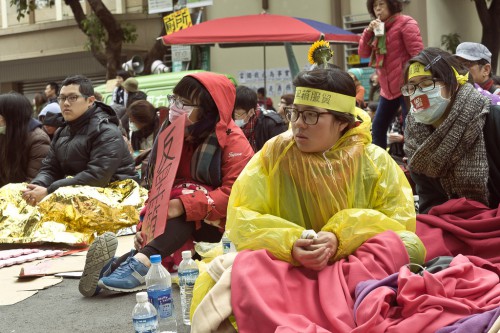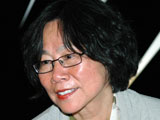The Magic Word “Occupy”
by Tienchi Martin-Liao / April 9, 2014 / 1 Comment
The Sunflower Movement in Taiwan

College students outside the ROC Legislative Yuan protest the unilateral passage of the Cross-Strait Service Trade Agreement. Photo: tomscy2000
Since September 2011’s Occupy Wall Street demonstrations, the Occupy model has become a global protest pattern. It goes hand-in-hand with new media, and has proved to be one of the most efficient and influential methods of attracting public attention and pressuring authorities. Occupy Central, a movement initiated in Hong Kong last spring, called on people to take over Central Plaza to appeal for universal suffrage, which should be realized in the executive and legislative elections of 2017 and 2020. To an extent, Hong Kong’s Occupy model has traveled across the China Strait and inspired the Taiwanese, even though Taiwan’s had its own tradition of street protest ever since the Meilidao Incident of 1979, which led to democratization in the country.

- During the Cultural Revolution, people were sentenced to death or outright murdered because of one wrong sentence. In China today writers do not lose their lives over their poems or articles; however, they are jailed for years. My friend Liu Xiaobo for example will stay in prison till 2020; even winning the Nobel Peace Prize could not help him. In prison those lucky enough not to be sentenced to hard labor play “blind chess” to kill time AND TO TRAIN THE BRAIN NOT TO RUST. Freedom of expression is still a luxury in China. The firewall is everywhere, yet words can fly above it and so can our thoughts. My column, like the blind chess played by prisoners, is an exercise to keep our brains from rusting and the situation in China from indifference.

- Tienchi Martin-Liao is the president of the Independent Chinese PEN Center. Previously she worked at the Institute for Asian Affairs in Hamburg, Germany, and lectured at the Ruhr-University Bochum from 1985 to 1991. She became head of the Richard-Wilhelm Research Center for Translation in 1991 until she took a job in 2001 as director of the Laogai Research Foundation (LRF) to work on human rights issues. She was at LRF until 2009. Martin-Liao has served as deputy director of the affiliated China Information Center and was responsible for updating the Laogai Handbook and working on the Black Series, autobiographies of Chinese political prisoners and other human rights books. She was elected president of the Independent Chinese PEN Center in October 2009 and has daily contact with online journalists in China.
On March 18 Taiwan’s Sunflower Movement officially began, perpetuating this history. Predominated by students and civic people, the movement is protesting Taiwan’s Cross-Strait Service Trade Agreement (CSSTA) with Mainland China. On March 30 over one hundred thousand protesters wearing black shirts gathered in front of the presidential palace. A group of opposing-forces of about the same size, wearing white shirts, also gathered to confront them. Ultimately, Taipei was occupied by three to four hundred thousand people over the weekend, all of whom enthusiastically demonstrated their political stance. Fortunately, things ended peacefully.
More than two weeks ago, students also occupied the parliament, or Legislative Yuan. Days later, they occupied the Executive Yuan, the highest administrative organ. Within 24 hours the police had successfully dispersed 2,000 occupants from the Executive Yuan, but let those camped at the Legislative Yuan stay. That is strange, but lots of unusual things have happened in the Legislative Yuan’s short history of democracy: Parliament members have climbed on desks and fought each other, shouting swears and insults; another time there was a woman who rushed into the House and exposed her breasts to declare her candidacy. But to see the House occupied by protesters for such a long time really is surprising. Such a thing has never happened before. The occupiers paralyze and humiliate the parliament for passing the CSSTA “in 30 seconds” instead of checking it clause-by-clause. They’re talking about a treaty that could harm the island’s economic and social stability, and could even endanger Taiwan’s independent existence. The protesters are demanding an apology from president Ma Ying-Jeou and want the trade pact cancelled.
Actually, the CSSTA was signed by China and Taiwan in June 2013. The agreement is based on the June 2010 Economic Cooperation Framework Agreement (ECFA), a preferential trade agreement that brought enormous benefits and helped Taiwan overcome trade barricades with neighboring countries. The CSSTA is just a part of the ECFA, which includes many fine details. But the protesters believe that the new treaty will leave Taiwan’s economy in the shadow of Mainland China and provide the opportunity to strangle Taiwan politically through economic power. The huge discrepancy of man power, investment funds, raw materials, market capacity, etc. between China and Taiwan has left the smaller island nation in a disadvantageous position. However, in trading with China, Taiwan also enjoys the favorable balance of the past.
The most worrisome part is that the pact allows mainland Chinese mangers and employers (but not the average laborer) to move to Taiwan, where they can live and work and benefit from the good local health care system. Considering Chinese migration in Tibet, the Uyghur area, and Mongolia—in which Han Chinese have enacted a policy of sinicization, effectively making indigenous peoples a minority in their homelands—could that also happen to Taiwan? With this vision in mind, people on the island are anxious.
The opposition Democratic Progressive Party (DDP) has played an active, but not decisive, role in the Sunflower Movement. In reality, it’s been taking advantage of the students’ naïveté to gain political capital for the next election. The situation offers the DDP a good chance to find fault with the Kuomintang (KMT) and blame president Ma Ying-Jeou for being “pro-China and selling out Taiwan,” an inciting phrase that catches young people’s attention and stirs up emotions. For the youth it’s cool to be part of the movement, to show your pride and identify as Taiwanese, to present good and educated behavior—to be nonviolent, rational. So far, so good. And while President Ma Ying-Jeou is neither a smart nor farsighted politician, he is understanding and tolerant of the student movement; he will not use military force to drive away the protesters, and is against the butcher method of Tiananmen Square. This time he has taken a steady position as a strong leader. Though there’s been no cancellation of the agreement.
The Sunflower Movement will last for a time, and since there’s no right and wrong, no black and white in such confrontations, no matter the outcome—as long as it ends peacefully—it’s a win-win situation. The government has shown tolerance and its ability to deal with a crisis. The people have shown moral courage and a clear sense of political participation. Today democratization in Taiwan is more mature then ever: It should be a lesson to the people and rulers of China.





One Comment on "The Magic Word “Occupy”"
Thank you for your in-depth analysis of Taiwan’s Sunflower Movement.